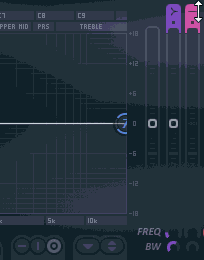

#Fruity parametric eq 2 download series#
Again, over the next few weeks I will be diving more in depth on each setting, and also shooting a video series all around EQ. I typically like subtractive EQ, turning problematic frequencies down in order to expose the wanted frequencies, which typically makes for a warmer, less harsh result. GAIN Once you have pointed at the right frequency then you need to decide if you want to boost (turn up) or cut (turn down). Just pointing to the freq does not effect the audio, it just puts you in the right spot so you can begin to operate. If you need to cut out some Low mid range mud, then point it to around 200-400 hz and pull a little out there. (turn up or down) If you need a little more air on the vocals, maybe point to some super high frequencies and boost a little. You got this! 1.Frequency This is the most important one, and allows you to point to which frequency you want to effect. So don't be intimidated if you see a 7 band EQ. Once you understand each control, then you will be able to control every EQ band, Low, Low mid, High Mid, High. I know there are only 3 in this pic, but I'll get to the 4th one in a bit. The 4 main controls you need to worry about I will focus on this type of EQ for the purpose of this article. There are bunch of Similarities between a parametric EQ and a Graphic Eq, but the main one used in recording studios during audio production is a Parametric EQ. (See below) The more bands a graphic EQ has the more fine tuned you can get, but all the frequencies overlap so you are always affecting the surrounding frequencies as well. On a graphic EQ you can really only pick a frequency and either boost or cut it. For example a 4 band graphic EQ vs a 31 band graphic eq. A graphic EQ is more of broad strokes,but can be more fine tuned depending on how many bands the graphic eq has. As mentioned above on a parametric EQ, you can dial in on a specific frequency and fine tune your decisions a little more. Parametric VS Graphic EQ The main difference between a parametric EQ and a Graphic EQ is how precise you can get.
.jpeg)
Things will get muddy and you will have less separation between tracks. You can cause phase issues and frequency masking, meaning sounds will cancel eachother out and you will hurt the overall sonic quality of your mix. You have to be careful with boosting too much of the same frequencies in a lot of different tracks. Soon we will be calling your Doctor cause you'll be so surgical! You can also boost frequencies to enhance or add sonic colorations to your tracks. You can literally carve out an eq spot thats just right, on a track by track basis. Not every track needs to occupy all the same frequencies. Once you have that initial balance, you can then use a parametric eq to get rid of unwanted frequencies that may be adding mud and harshness to your mix. By the way, BALANCE is the key! Spend some time with just your volume faders and pan knobs BEFORE you add EQ or compression. A regular volume fader will allow you to turn up or down a whole track to achieve a balance with the other tracks. If you dive in, an EQ really just turns up or down the volume, not of the whole track, but of a specific frequency you've selected. In the next few weeks I will be diving more in depth into this topic, but today I want you to understand the controls of a Parametric EQ and what they mean so you can be on your way to using any EQ like a boss! It's just a volume fader! An EQ is just a really smart volume fader.

#Fruity parametric eq 2 download full#
Using a Parametric EQ to it's full potential is what separates the men form the boys, the pros form the amateurs. Understanding the proper way to use an EQ will yield you warmth, space, glue, clarity, and an overall pleasant musical experience that we all want to create. One of the most powerful tools you can have in your mixing arsenal is a Parametric EQ.


 0 kommentar(er)
0 kommentar(er)
